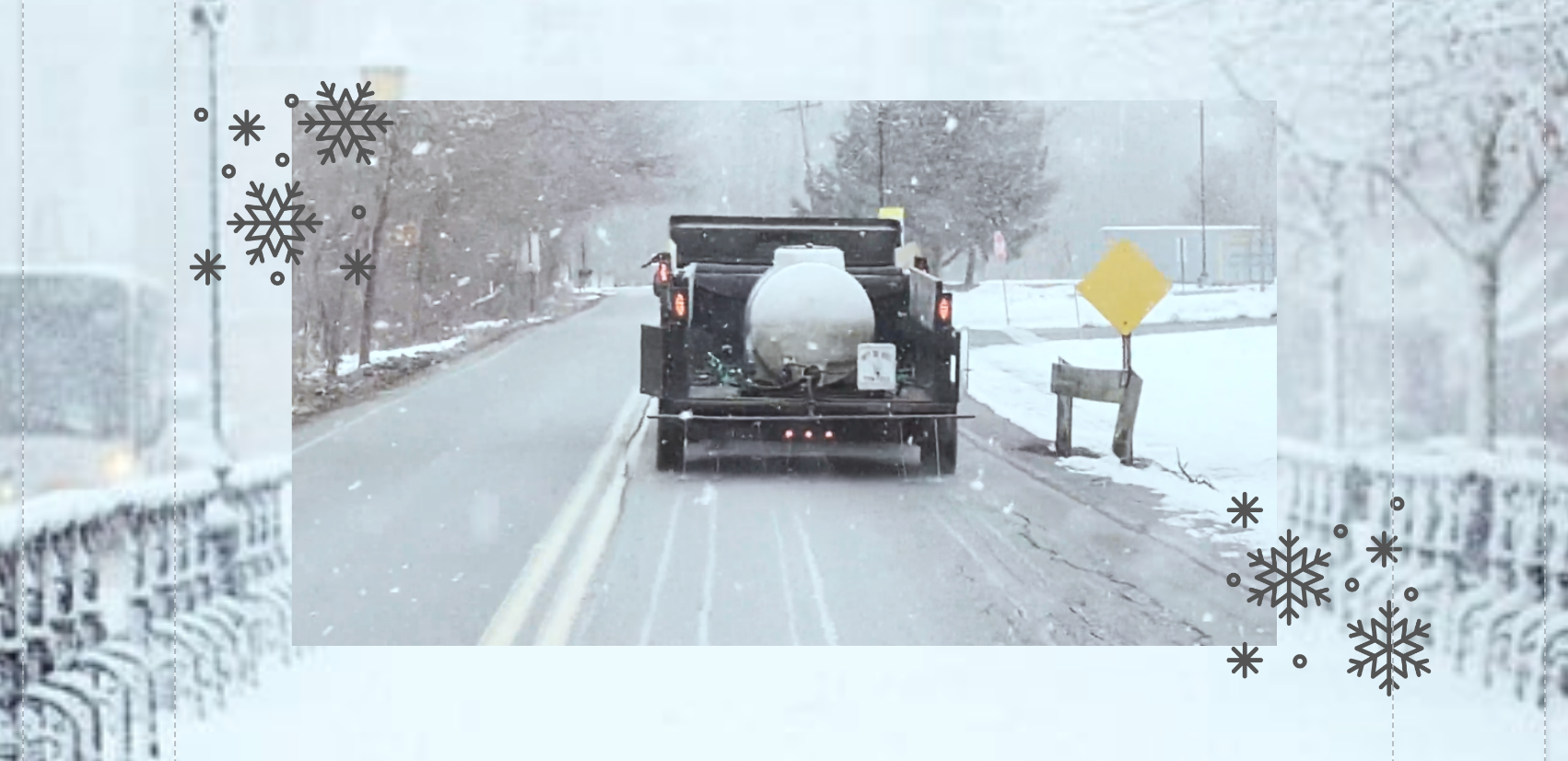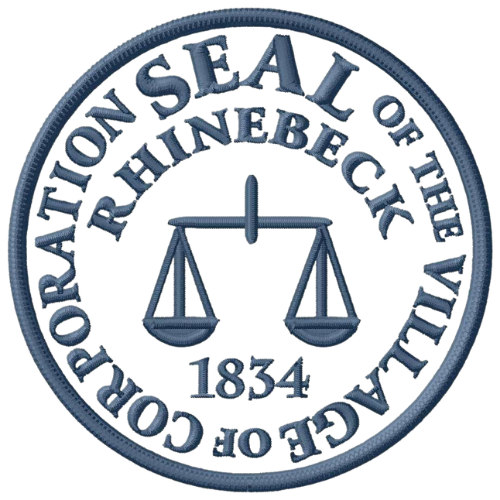
Reducing Road Salt
News
January 2023: Village Board Approves Purchase of Brining Equipment
The sprayer and tank, mountable on a trailer, will assist the Highway Department in pre-treating roads with salt brine in advance of appropriate winter storms. The Village was able to purchase the equipment used from Dave’s Tree Service.
Dutchess County Environmental Management Council spotlights Rhinebeck in case study about using brine
Genesis of the Road Salt Reduction Project
In Summer/Fall 2020, a concern was brought forward by Dan Shapley, Rhinebeck resident and Director of Water Quality Programs at Riverkeeper. All over the Northeast, excess road salt is seeping into surface water, drinking water and generally degrading ecosystems. Inspired by the adaptations happening around Lake George in the Adirondacks, Village Mayor Gary Bassett pushed for us to look into solutions, so Village Trustee Vanessa Bertozzi met with Josh Pulver on the Town Board and Highway Superintendent Bob Wyant.
Left to right, at the Town Highway Garage’s salt pile: Town Highway Department Superintendent Bob Wyant, with Rhinebeck resident Dan Shapley and Town Board Councilperson Josh Pulver (Photo by Village Trustee Vanessa Bertozzi)
Pilot Program Winter 20/21
Have you ever brined your Thanksgiving turkey? It’s basically a simple salt water mixture. Did you know salt brine is used on roads during the winter months? You may have noticed salt brine trucks already on highways. For many years, NY State DOT has used brine extensively. It’s a proven and safe method to pre-treat roads for winter weather.
Both Village and Town highway departments are always working to incorporate the latest technologies and processes for greater efficiencies and modernization. In researching brine, we found it to be a tool that makes sense on these fronts:
Winter safety: Keeping the roads clear and safe is the number one priority for both of our highway departments. The departments are thoroughly researching techniques, interviewing other departments that use salt brine and visiting other operations.
Cost savings: You only use about 23% of the amount of salt to make enough brine equivalent to a rock salt run. With certain types of snowfall, a brine run could preclude a secondary rock salt run. It also provides a highway department more flexibility before a storm, reducing the need for overtime labor and associated costs.
Environmental: Less salt contamination our streams, river, wetlands, lakes and ponds means a more resilient ecosystem, better able to withstand the pressures of climate change and invasive species.
Public health: Drinking wells contaminated with excess salt levels contribute to hypertension and other health issues, and in extreme, could render wells unusable.
Using salt brine is not a silver bullet—it does not fully replace rock salt. Think of it as another tool in a highway department’s toolkit. Brine is best used to pre-treat the roads before a storm. The goal is to lessen the overall amount of rock salt and reduce the “bounce and scatter” off to roadsides where rock salt seeps into the ground.
In Fall 2020, Town Highway Supervisor Bob Wyant, staff from the Village Highway Department, Mayor Gary Bassett, Village Trustee Vanessa Bertozzi, Town Councilperson Josh Pulver, Dan Shapley, and Bard CEP intern David Chernack met at the Town Garage to discuss options. Bob Wyant shared his research (view as PDF).
The Town’s salt brine truck, set up Fall 2020
The Town’s salt brine -maker set up, Winter 2020
During Winter 20/21, the Town and Village Highway Departments are collaborating to try out using brine on our roads, if the appropriate type of snow falls. The Town has adapted a truck for salt brine spraying, and a brine-maker set up.
In a strategy to first test whether brine is effective on Village streets (where vehicle speeds are slower), the Village is pursuing contracting out the brining of Village streets during the pilot. We are exploring sources to get the salt brine solution or low cost ways to make it onsite at the Town Garage. (It’s important to note that the Town houses road salt, and typically, the Village Highway Department purchases it from the Town.)
We will carefully use brine on a portion of our streets prior to appropriate weather events. When Highway Departments see the right type of snow storm on the horizon, they’ll put out the word to get the brine ready.
If using salt brine works the way it’s intended during this pilot, Town and Village could explore an inter-municipal agreement (IMA) and potentially, shared-services grant opportunities to invest in salt brine equipment.
Finding Solutions to Road Salt: Enter the Brine
Using salt in solution—aka brine—can greatly reduce the total amount of salt we use to make our roads safe in winter, with benefits for humans and the environment.
by David Chernack, Bard CEP Intern for the Rhinebeck Joint Town/Village Environmental Committee
Even as a warming climate shrinks the number of snowfall events and total snow accumulation in the Northeast, winter road maintenance is a tricky and expensive task for small municipalities. The most ubiquitous tool in a town or village’s arsenal to combat black ice, heavy snow, or slushy sleet is rock salt: crystals of sodium chloride, sometimes mixed with sand to increase traction. It’s hard to imagine braving a grocery or pharmacy run in the immediate aftermath of a storm without the stuff.
Unfortunately, several modern studies have revealed that road salt can wreak havoc on freshwater ecosystems. When melted snow and ice are contaminated with salt, the resultant water is denser than freshwater. That means that when it is washed away into natural waterways, this salty water will settle at the bottoms of lakes and ponds where currents are slow or nonexistent.
As a result, chemical stratification—which can impede water mixing—prevents dissolved oxygen closer to the surface of the waterbody from reaching the bottom. Similarly, nutrients closer to the bottom layers are prevented from cycling upward. The end result of this phenomenon is that the bottom layer of a pond or lake can be totally drained of life-giving oxygen, and be rendered unlivable for aquatic organisms.
Furthermore, excess road salt can also make its way into drinking water. Road salt infiltration into groundwater-based water supplies—such as wells, springs, and reservoirs—is becoming increasingly common in the Northeast. Massachusetts has been monitoring this issue for decades, reporting that NaCl concentrations of 75mg/L in certain wells is not uncommon. Extra salt in drinking water—even if it cannot be detected to taste—can contribute to health issues like hypertension, which are brought on and exacerbated by salt intake.
Back on dry land, overexposure to salt can affect wildlife directly by causing toxicosis—especially in birds, which are particularly sensitive to excess NaCl. Deer and moose, which are attracted to salt, can be drawn to roadsides by excess road salt, increasing the frequency of collisions with vehicles. And salt intrusion into soil can lead to the increased prevalence of salt-tolerant plant species—such as invasive Phragmites—decreasing biodiversity and harming all aspects of the ecosystem.
Recognizing the acute effects of road salt on the Northeast’s ecology and natural health, what are municipalities to do to balance the transportation needs of its residents, its businesses, and its ecosystems?
Enter salt brine, a cousin to normal road salt.
What is salt brine?
Salt brine is a solution of salt (sodium chloride, or NaCl) and water. It has a much lower freezing point than freshwater, and is a useful tool in reducing the adhesion of snow and ice to road surfaces. While some brine cocktails are exclusively saltwater, some include calcium chloride or magnesium chloride. Brine is applied to road surfaces in its liquid form by spray applicator trucks.
How does salt brine work? How is salt brine different from rock salt?
Brine, unlike road salt, is an anti-icing agent, and must be applied before a weather event in order to be effective. Essentially, applying brine to road surfaces is a proactive approach that decreases the likelihood of snow and ice freezing to road surfaces. As mentioned before, anti-icing with brine involves applying a thin layer of brine to pavement a few hours before a winter storm begins. This means that highway departments must anticipate storms for which anti-icing with brine would be effective.
How is salt brine different from rock salt?
The alternative to brining, which is called de-icing, is to let the snow or slush freeze to the road, then apply pre-wetted rock salt to that road surface. This raises the freezing temperature of the icy surface and essentially melts the ice away. And while brine does contain salt—which as we discussed previously, is detrimental to environmental health—brine can do the work of rock salt using up to 80% less NaCl by weight. That means that a whole lot less salt is making it into our soils and waterways after a long winter season.
Brine has its disadvantages, however. As an anti-icing agent, highway departments must correctly anticipate when an incoming storm will hit—and if the weather event ends up being a dud, brine will have been laid down fruitlessly. Additionally, just like rock salt, road salt brine isn’t easy on the underside of vehicles. However, prudent application of salt brine can greatly reduce the tonnage of salt that is used to make roads safe over the course of a winter season.
I’ve heard about additives in salt brine sourced from hydrofracking wastes—what’s up with that?
Due to a loophole in New York State’s laws governing the use of potentially hazardous wastes from hydrofracking (“fracking”)—as well as other wastes from the oil industry—byproducts and wastes are technically legal to use as additives to brine. These waste products can include heavy metals and chemical additives used in the fracking process, such as benzene; wastes from Pennsylvania’s Marcelus shale formation can even include radium isotopes.
Usage of these fracking fluids is not the norm, however. And additionally, a new law passed by the state legislature last year—but still awaiting Governor Cuomo’s signature—would disallow the use of fracking wastes for brine mixing from our neighbors who frack (namely Pennsylvania) and use it in their brine cocktails.
The bottom line...
...is that while road brine isn’t a cure-all solution to making our roads safe in wintertime, it’s a cost-effective step forward for municipalities that want to reduce the amount of salt they’re putting into their ecosystems. Investing in brine infrastructure—and ensuring that safe materials are used when making and applying brine—is a prudent idea for both our budgets, our roadways, and our ecosystems.
Where can I learn more?
The Cary Institute for Ecosystem Studies in Millbrook has been leading pioneering research on road salt’s effects on freshwater ecosystems for years; read about their work here. The New Hampshire Department of Environmental Services also has a great primer on the effects of road salt on human and ecosystemic health.




